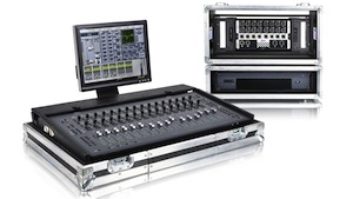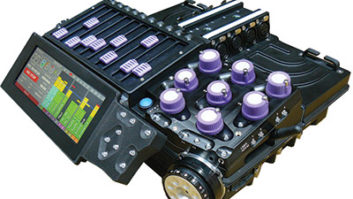Avid Pro Tools 10The 131st Audio Engineering Society Convention demonstrated just how thoroughly the personal computer and software have come to dominate and influence audio production. Exponential increases in functionality and versatility had convention visitors flocking to the exhibits featuring DAW and related products.

To the surprise of no one, Avid’s exhibit saw the most traffic, illustrating its products’ leading role in recording and mixing, post production and, more recently, sound reinforcement.
Avid’s unveiling of Pro Tools|HDX and Pro Tools 10 was the talk of the convention. The new system, says Avid, delivers up to five times more processing power than previous-generation cards; over 1,000 dB of internal headroom and higherresolution sound, by virtue of 32-bit, floating-point architecture; and up to four times the playable track counts and 64 channels of I/O per card. The system can be scaled with up to three Pro Tools|HDX cards and multiple Pro Tools HD Series interfaces.
Lexicon MPXWith Pro Tools HD 10, Avid launches its new AAX (Avid Audio eXtension) plug-in format, which it says allows better workflows between DSP-accelerated and native Pro Tools systems.

Pro Tools 10 software adds features including Clip Gain, which separates pre-mix levels from mixing automation. Formerly known in Pro Tools as regions, clips are manipulated via Clip Gain’s display, featuring a volume readout and fader icon with which the user can raise or lower the clip’s volume. The waveform provides real-time visual feedback by adjusting to the fader moves.
SSL DuendeSonnox wasted no time in announcing compatibility of its Oxford Plug-ins with the AAX format for Pro Tools|HDX and Pro Tools 10, beginning with the Oxford Inflator and Oxford EQ. “They will be available as soon as Pro Tools [|HDX] is available,” said Sonnox audio software engineer Matthew Morton. “We’re also showing the new 64-bit native range, so we now support 64-bit VST and Audio Units, with new GUIs as well—they got a bit of a polish.” The convention also saw the AES debut of Sonnox’s Fraunhofer Pro-Codec, designed to provide real-time auditioning of audio codecs within the DAW environment.

Solid State Logic is now an official Avid Development Partner, and announced the release of new RTAS versions of its Duende Native plug-in collection. “We now have all of the SSL Duende native plug-ins available in RTAS format,” explained Jim Motley, head of business, Workstation Partner Products. “So we have the [EQ and Dynamics] Channel Strip, the Stereo Bus Compressor, the technical tools like X-EQ, X-Comp and X-Verb. Also, DrumStrip and Vocal- Strip are available in a Pro Tools native environment.”
iZotope debuted Ozone 5 and Ozone 5 Advanced at the 131st AES. “They’re updates to our flagship product line—our complete mastering suite—and we’ve completely redesigned all of the underlying DSP,” explained Victoria Kane, artist relations/ marketing. “We’ve focused on pristine sound quality, optimized the workflow, redone the [user interface], and really have given a focus on the feature requests we were getting. Some [requests] were being able to use the component plug-ins individually— there are seven in Ozone 5 Advanced. We used to have to throw the whole mothership on a track, as opposed to just the limiter, or the EQ. In Advanced, you now have the option to use the individual component plug-ins.”
Of the DSP, Kane adds, “Some technology that we’re famous for, like the Loudness Maximizer or the IRC Limiter, we’ve redone from the ground up. It sounds better than ever, and we’ve been getting great response, especially from the beta testers. We’re really excited to put it out.”
Inside the Harman Pro truck parked on the exhibit floor, Lexicon demonstrated the new MPX Native Reverb Plug-In, with a MAP of $199.95. The MPX plug-in is controlled via a single-screen interface and offers seven Lexicon reverb types and 100-plus presets.
“Aside from getting to a price point we’d like, the idea is it’s targeted more at the first-time mixer,” explained Michael Carnes, principal engineer, Lexicon Professional. “That may be a student, a young person starting out, or maybe the video guy that got audio thrown in his lap. So ease of use is the primary thing. Having said that, there’s stuff in here that’s not in any of our other plugs. The biggest is that now, instead of having separate plug-ins, we can change the reverb type right inside the plug. Some of the controls are familiar, but a lot, like the early reflections, is now one knob. We have a set of patterns you dial until you like one. We give a large set of presets, organized by size: We go from vocal booths up to giant spaces and several stops along the way.”
Barely two weeks after the untimely passing of Apple co-founder Steve Jobs, a demonstration of his innovative and even revolutionary products was on display at the AES Convention. Neyrinck’s V-Control Pro, a DAW controller for the hugely popular Apple iPad, was first shown at the 129th AES Convention in 2010. Initially for Pro Tools, V-Control Pro is now compatible with Logic and Cubase/Nuendo as well.
“It’s a very full-featured control surface,” observes company president Paul Neyrinck, “a very ergonomic design with multi-touch, so you can use it as a mixing controller. It’s got banking, scrolling, track select, pan control, solo, mute, record, automation control on every track. It’s got dual surround panners, [and] you can switch between the edit and mix window on your Pro Tools system. Global group suspend, automation suspend, location keypad, transport—a very full-featured control surface.”
In the ever-more-relevant field of audio restoration, Celemony introduced Capstan—standalone software that addresses wow and flutter problems associated with decayed or otherwise marred recordings. “It does what it does based on the music that’s in the recording,” explained Stefan Lindlahr, senior product manager, quality assurance, “so you don’t need to have the original medium anymore. It’s OK to have a digital transfer of it, which often is the case. Load in the file and Capstan does an analysis of the pitch fluctuation. The trick is to decide whether the fluctuation was intentional (like playing with vibrato) or from a mechanical problem.”
Capstan, Lindlahr continued, is based on Celemony’s Melodyne technology, “which is unique in the sense of being able to find notes in a polyphonic audio file. This means the more notes, the easier it is for Capstan to correct the problem. This also explains the limits: If you have only one musician playing a monophonic melodic line, it’s harder to get rid of the problem. As long as it’s many musicians playing together, it’s actually pretty easy.”
While the importance of audio restoration is growing, Waves announced a strategic partnership with the source of many of the world’s older and most revered recordings, Abbey Road Studios. The software developer has announced an ongoing collaboration with Abbey Road engineers to create a series of audio plug-ins, theoretically bringing the “Abbey Road sound” to any DAWbased recordist.
Further demonstrating that everything old is new again, Softube showed plug-ins based on a multitude of classic hardware. “Other than for surgical reasons, I like plugins with character,” commented AES attendee, engineer/producer Michael O’Reilly. “Softube has a Valley People Dyna-mite that’s just as aggressive and noisy as the original. [It’s] great for certain things— nothing shy about it; also a Trident A-Range EQ—very musical-sounding. I also like their FET Compressor: very ‘1176’-sounding. While not as new, their TubeTech CL 1B is great, along with their new [Summit Audio] TLA 100.”





